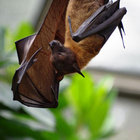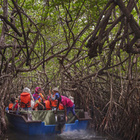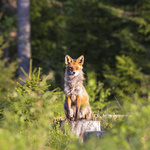Viruses, animals and people
Skills and objectives
The students will …
- Be given basic information about the transmission of infectious diseases from animals to humans (zoonotic diseases)
- Build their functional skills by correctly matching images and texts and placing them in logical order
- Sharpen their critical thinking skills by reflecting on their existing knowledge about the emergence of the coronavirus, and correcting it if necessary
- Improve their communication and presentation skills by talking about their findings and working together to develop solutions
Procedure
Main questions for this lesson:
- How can diseases pass from animals to humans?
- How is the way we deal with animals and nature linked to infectious diseases?
Warm-up
At the start of the lesson, the students discuss the following question (as a group or by video conference): "Where does the coronavirus come from?" Their existing knowledge and assumptions are noted down.
The teacher then tells the class that according to scientists, the coronavirus originates from animals. S/he explains that the purpose of the lesson is to explore this in more detail. The teacher also presents the main questions for the lesson.
The students start by completing a quiz (see materials) which draws their attention to other zoonotic diseases (e.g. rabies). The quiz also provides some basic information on how infectious diseases are passed from animals to humans.
Student exercise
The students look at various ways in which infectious diseases are passed from animals to humans.
They are given a worksheet, entitled "From animals to people: the virus’s journey". The worksheet includes photos and short texts. The students are asked to complete an exercise which involves matching the photos and texts and putting them in the correct order. The photos and texts describe how viruses can be passed from animals to humans.
The students then describe the various transmission pathways of infectious diseases in their own words.
Wrap-up
The students present their findings to the group (in class or by video conference).
The teacher then gives an example of how a disease can be transmitted from humans to animals: flu viruses can be passed onto mountain gorillas and other great apes if infected humans get too close to the animals.
The teacher also emphasises that transmission of animal pathogens is most likely to occur when humans encroach on natural habitats, not when wild animals are already living around humans. For example, someone who has a hedgehog – a wild animal – in their garden does not need to worry about disease. In general, though, it is best just to watch wild animals and not touch them.
Lastly, based on the transmission pathways identified, the students work together to develop ideas on how the transmission of diseases between humans and animals can be prevented.
Conclusions to be drawn by the students (with support from the teacher): Coronavirus means that we have to keep our distance from each other. The same applies to animals – they need space around them to prevent the rapid transmission of disease (no intensive livestock farming). Humans should also avoid direct skin contact with wild animals and keep their distance.
Next step
- The students design posters showing how to prevent the spread of zoonotic diseases (messages include: keep contact with wild animals to a minimum – stop wildlife trade; protect natural habitats, etc.).
![]() Dieses Werk ist lizenziert unter einer
Creative Commons Namensnennung - Weitergabe unter gleichen Bedingungen 4.0 International Lizenz.
Dieses Werk ist lizenziert unter einer
Creative Commons Namensnennung - Weitergabe unter gleichen Bedingungen 4.0 International Lizenz.
Sie dürfen diesen Text unter anderem ohne besondere Genehmigung verwenden und bearbeiten, z.B. kürzen oder umformulieren, sowie weiterverbreiten und vervielfältigen. Dabei müssen www.umwelt-im-unterricht.de als Quelle genannt sowie die oben genannte Creative Commons-Lizenz verwendet werden. Details zu den Bedingungen finden Sie auf der Creative Commons-Website.
![]() Umwelt im Unterricht unterstützt die Erstellung von Bildungsmaterialien unter offenen Lizenzen im Sinne der
UNESCO.
Umwelt im Unterricht unterstützt die Erstellung von Bildungsmaterialien unter offenen Lizenzen im Sinne der
UNESCO.

The COVID-19 pandemic has focused attention on the fact that most infectious diseases originate from animals. According to experts, more of these diseases can be expected in future. The reasons for this lie in human interaction with nature.
mehr lesen
Do blue fever, kangaroo hiccups and rabies really exist? A quiz aims to raise students’ awareness of zoonotic diseases. By arranging texts and photos in the correct order, they gain an understanding of how infectious diseases are transmitted from animals to humans.
mehr lesen
